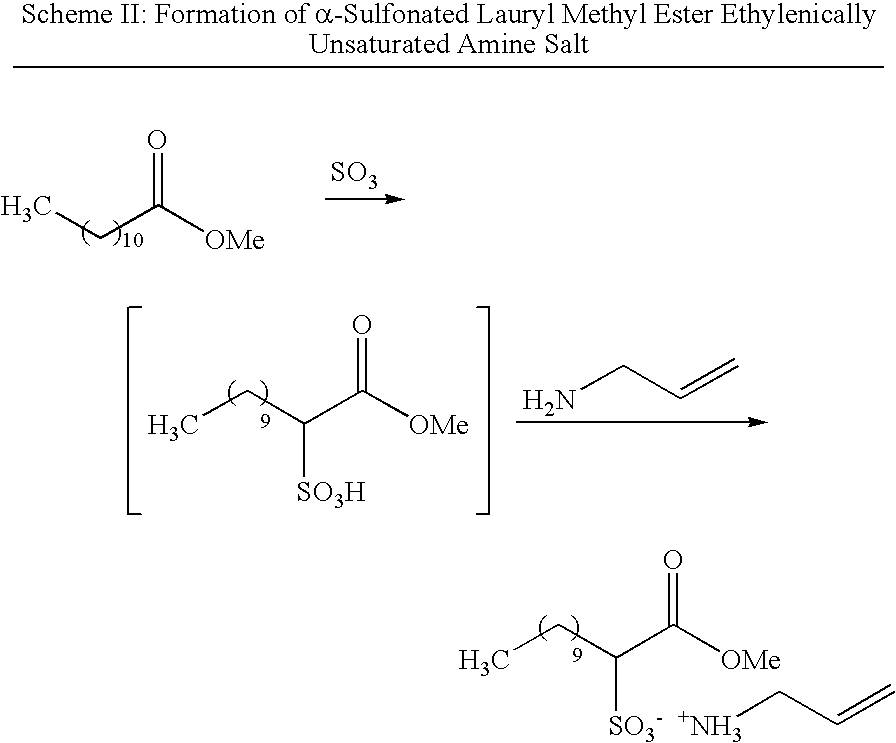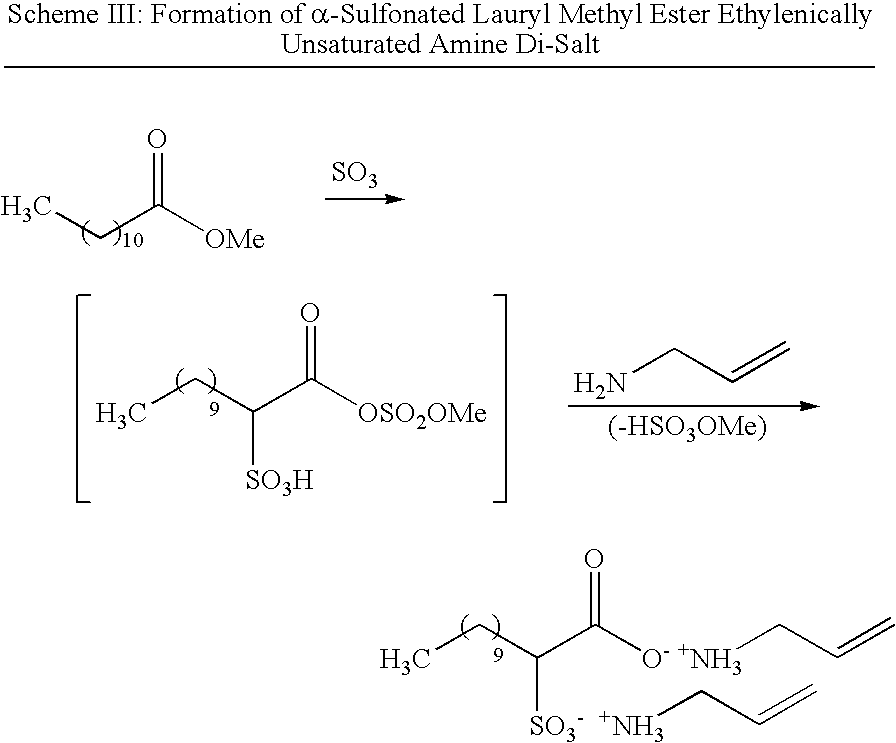Antimicrobial polymer latexes derived from unsaturated quaternary ammonium compounds and antimicrobial coatings, sealants, adhesives and elastomers produced from such latexes
a technology of unsaturated quaternary ammonium compounds and antimicrobial polymer latexes, which is applied in the field of improved coatings, adhesives, sealants and elastomers (case) materials, can solve the problems of adversely no longer desirable surfactants, and affecting the resistance of the case material, so as to improve the resistance to scrubbing and improve the water sensitivity. , the effect of improving the resistan
- Summary
- Abstract
- Description
- Claims
- Application Information
AI Technical Summary
Benefits of technology
Problems solved by technology
Method used
Image
Examples
example 1
[0217]A methylmethacrylate / butylacrylate / methacrylic acid (MMA / BA / MMA) co-polymer (in a weight ratio of about 48:49:3), in combination with the allylamine salt of dodecylbenzenesulfonic acid (ADDBS), is prepared as follows. About 254 g of deionized water and about 10.6 g of ADDBS (as a 22% active aqueous solution), are placed in a reactor suitable for emulsion polymerization, equipped with agitation means, heating means and cooling means. With agitation, the reactor is purged with nitrogen (99% pure), and heated to about 80-82° C. The temperature of the reactor contents is adjusted to about 77-79° C., and about 75 g of the monomer mixture (20% of a total of 374 g of the MMA / BA / MMA monomer mixture in the ratio above) is added to the reactor. After 10 minutes, 16.9 g of a solution of ammonium persulfate (20% of the total solution of 1.9 g of ammonium persulfate dissolved in 82.5 g of water) is added to the reactor over a period of about 7 minutes with continued agitation, during which...
example 3
[0219]A methylmethacrylate / butylacrylate / methacrylic acid (MMA / BA / MMA) co-polymer (in a weight ratio of about 46.1:50.8:3.1) in combination with the allylamine salt of nonyl phenol 9-EO phosphate acid ester (Cedephos CP-610) is prepared as follows. About 249 g of deionized water and about 11.0 g of the allyl amine salt of Cedephos CP-610 (as a 20% active aqueous solution), are placed in a reactor suitable for emulsion polymerization, equipped with agitation means, heating means and cooling means. With agitation, the reactor is purged with nitrogen (99% pure), and heated to about 75 77° C. The temperature of the reactor contents is adjusted to about 71-74° C., and about 74 g of the monomer mixture (20% of a total of 371 g of the MMA / MMA monomer mixture in the ratio above) is added to the reactor. After 10 minutes, 15 g of a solution of ammonium persulfate (20% of the total solution of 1.9 g of ammonium persulfate dissolved in 74.0 g of water) is added to the reactor over a period of ...
example 5
[0221]A methylmethacrylate / butylacrylate / methacrylic acid (MMA / BA / MMA) co-polymer (in a weight ratio of about (48:49:3), in combination with the allylamine salt of lauric acid (ALA) is prepared as follows. About 205 g of deionized water and about 1.6 g of ALA (as a 20% active aqueous solution), are placed in a reactor suitable for emulsion polymerization, equipped with agitation means, heating means and cooling means. With agitation, the reactor is purged with nitrogen (99% pure), and heated to about 70-73° C. The temperature of the reactor contents is adjusted to about 71-73° C., and about 75 g of the monomer mixture (20% of a total of 374 g of the MMA / BA / MMA monomer mixture in the ratio above) is added to the reactor. After 10 minutes, 15 g of a solution of ammonium persulfate (20% of the total solution of 1.8 g of ammonium persulfate dissolved in 75.0 g of water) is added to the reactor over a period of about 10 minutes with continued agitation, during which time there is an exot...
PUM
| Property | Measurement | Unit |
|---|---|---|
| time | aaaaa | aaaaa |
| time | aaaaa | aaaaa |
| temperature | aaaaa | aaaaa |
Abstract
Description
Claims
Application Information
 Login to View More
Login to View More - R&D
- Intellectual Property
- Life Sciences
- Materials
- Tech Scout
- Unparalleled Data Quality
- Higher Quality Content
- 60% Fewer Hallucinations
Browse by: Latest US Patents, China's latest patents, Technical Efficacy Thesaurus, Application Domain, Technology Topic, Popular Technical Reports.
© 2025 PatSnap. All rights reserved.Legal|Privacy policy|Modern Slavery Act Transparency Statement|Sitemap|About US| Contact US: help@patsnap.com



